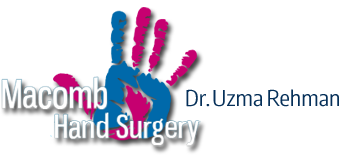Surgeons Answer Wrist Fusion Surgery FAQs
Wrist fusion surgery – medically called “wrist arthrodesis”- is a surgical procedure that joins the bones in the wrist in an effort to reduce severe pain. While it is typically a “last resort” in conditions that don’t respond to other treatments, it can significantly reduce or eliminate unbearable pain in patients with certain medical conditions.
In this article, Oakland County board-certified hand surgeon Dr. Uzma Rehman will help you understand elbow replacement surgery, including Read the different types of wrist fusion surgery and what happens during the procedure.
Why is wrist fusion surgery done?
When wrist fusion surgery is done to treat severe wrist arthritis or injuries, it’s typically only considered as an option when other nonsurgical treatments have failed to help the condition or alleviate the pain.
What does wrist fusion surgery treat?
The most common reason for wrist fusion surgery is to treat severe arthritis, including: rheumatoid arthritis, osteoarthritis or traumatic arthritis.
However, wrist fusion surgery can also be an effective treatment for: wrist fractures, severe wrist ligament injuries, Kienbock’s disease, Preiser disease, and certain genetic disorders.
What are the benefits of wrist fusion surgery?
While wrist fusion surgery can involve part of the wrist or the entire wrist, its goal is typically to reduce pain and increase the strength of the patients grip so they can perform regular daily tasks. Wrist fusion surgery can also increase wrist stability.
It should be kept in mind, however, that since wrist fusion surgery fuses the wrist joint, it will no longer flex or extend as usual. So, there will be some limitation of wrist mobility and function.
What are the types of wrist fusion surgery?
There are several types of wrist fusion surgery, and board-certified hand surgeon Dr. Uzma Rehman will discuss the specifics of your procedure and what to expect with you. However, the steps of different wrist fusion surgeries are generally the same.
Wrist fusion can be total (involving the entire wrist) or partial (involving just a part of the wrist). The most common wrist fusion techniques include:
Radio-scapho-lunate fusion: used when the patient has arthritis in the radiocarpal joint but not in the midcarpal joint. This typically happens after fractures in the radius bone.
Radio-lunate fusion: often used to treat rheumatoid arthritis and instability in certain parts of the wrist, including the midcarpal joint.
Scapho-luno-capitate fusion: used to treat midcarpal arthritis when patient has a healthy radiocarpal joint. The surgery involves fusing the bones in the midcarpal joint.
Four-corner fusion: this technique is commonly used for the advanced stages of severe arthritis. It is a partial wrist fusion that preserves some movement in the wrist as well as improving grip strength. Special screws or a circular plate may be used in this partial fusion.
How is recovery like after wrist fusion surgery?
It typically takes up to 3 months to recover from wrist fusion surgery. Patients must avoid placing weight on the wrist for about 2 weeks and will need to wear a brace during this time.
After 2 weeks the surgeon will usually remove the stitches and start physical therapy around this time. Rehabilitation with our skilled and certified physical therapists is critical to the success of any wrist fusion surgery. Patients will learn exercises for the hand and wrist to avoid stiffness, control swelling, reduce pain, and improve range-of-motion exercises as the incision heals.
Wrist Fusion Surgeon | Oakland County
If you are suffering from arthritis, severe pain in your wrist, loss of grip strength, or other wrist problems contact board certified Oakland County hand surgeon Doctor Rehman for a comprehensive evaluation and consultation. She will discuss your treatment options with you with skill, compassion and years of experience – and recommend the best treatment to help you relieve your pain and resume the activities that you enjoy.

